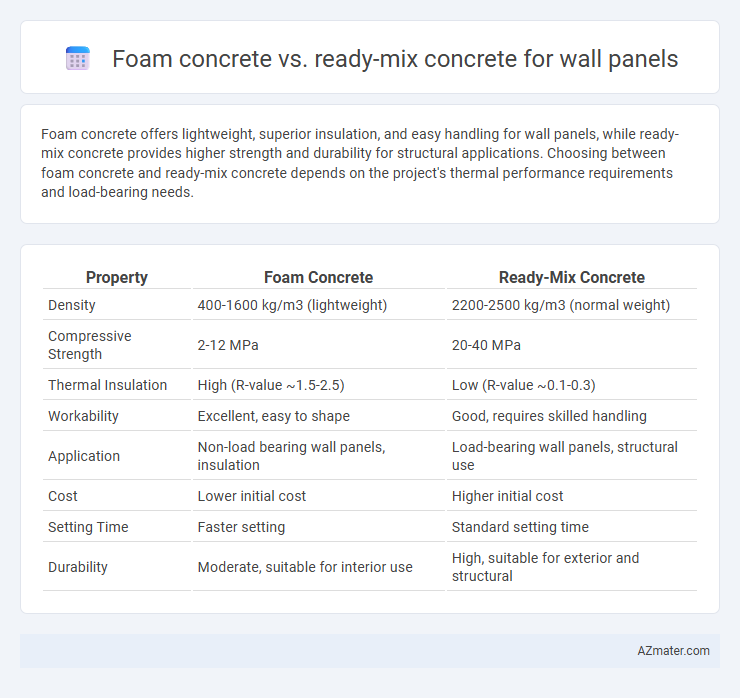Foam concrete offers lightweight, superior insulation, and easy handling for wall panels, while ready-mix concrete provides higher strength and durability for structural applications. Choosing between foam concrete and ready-mix concrete depends on the project's thermal performance requirements and load-bearing needs.
Table of Comparison
| Property | Foam Concrete | Ready-Mix Concrete |
|---|---|---|
| Density | 400-1600 kg/m3 (lightweight) | 2200-2500 kg/m3 (normal weight) |
| Compressive Strength | 2-12 MPa | 20-40 MPa |
| Thermal Insulation | High (R-value ~1.5-2.5) | Low (R-value ~0.1-0.3) |
| Workability | Excellent, easy to shape | Good, requires skilled handling |
| Application | Non-load bearing wall panels, insulation | Load-bearing wall panels, structural use |
| Cost | Lower initial cost | Higher initial cost |
| Setting Time | Faster setting | Standard setting time |
| Durability | Moderate, suitable for interior use | High, suitable for exterior and structural |
Introduction to Foam Concrete and Ready-Mix Concrete
Foam concrete is a lightweight, aerated material created by mixing cement, water, and foam, providing excellent insulation and reduced density for wall panels. Ready-mix concrete is a pre-mixed blend of cement, aggregates, water, and admixtures designed for consistent strength and quality, commonly used in structural wall panels. Both materials offer specific benefits, with foam concrete emphasizing thermal efficiency and ready-mix concrete prioritizing durability and uniform composition.
Composition and Materials Used
Foam concrete for wall panels incorporates cement, water, fine aggregates, and a foaming agent that introduces air bubbles, resulting in a lightweight and insulating material. Ready-mix concrete consists of cement, water, coarse and fine aggregates, and sometimes admixtures, providing higher strength and durability for structural applications. The air content in foam concrete reduces density and thermal conductivity, whereas ready-mix concrete emphasizes compressive strength and uniform consistency.
Manufacturing and Mixing Processes
Foam concrete is produced by blending cement, water, and fine aggregates with a pre-formed foam generated from a foaming agent, resulting in a lightweight, aerated mixture ideal for wall panels. Ready-mix concrete involves precise batching of cement, aggregates, water, and admixtures at a centralized plant, followed by transportation to the site for immediate use, ensuring consistent quality and strength. The manufacturing of foam concrete requires careful control of foam density and stability to achieve desired thermal insulation, while ready-mix concrete emphasizes uniform mixing and timely delivery to maintain workability and structural integrity.
Key Physical and Structural Properties
Foam concrete offers lower density and superior thermal insulation compared to ready-mix concrete, making it ideal for lightweight wall panels with enhanced energy efficiency. Ready-mix concrete provides higher compressive strength and durability, suitable for load-bearing wall panels requiring robust structural integrity. The choice between foam concrete and ready-mix concrete depends on specific project requirements like weight reduction, insulation needs, and strength demands.
Advantages of Foam Concrete for Wall Panels
Foam concrete offers superior thermal insulation and lightweight properties compared to ready-mix concrete, significantly enhancing wall panel energy efficiency and reducing structural load. Its excellent sound absorption and fire resistance improve building safety and comfort, while easy moldability enables custom shapes and sizes for diverse architectural designs. Foam concrete's eco-friendly composition with reduced cement content lowers carbon footprint, making it a sustainable choice for modern construction projects.
Benefits of Ready-Mix Concrete in Wall Panel Applications
Ready-mix concrete offers superior consistency and quality control for wall panel applications, ensuring uniform strength and durability that foam concrete often lacks. Its high compressive strength and enhanced workability facilitate faster installation and reduce construction time. Moreover, ready-mix concrete's optimized mix designs improve load-bearing capacity and resistance to environmental stresses, making it ideal for structural wall panels.
Thermal and Acoustic Insulation Performance
Foam concrete offers superior thermal insulation for wall panels due to its low density and high air content, effectively reducing heat transfer and enhancing energy efficiency. Its porous structure also provides excellent acoustic insulation, dampening sound transmission better than standard ready-mix concrete. Ready-mix concrete, while strong and durable, typically has higher thermal conductivity and lower sound absorption, making foam concrete a preferred choice for soundproof and thermal-efficient wall panels.
Cost Comparison and Economic Considerations
Foam concrete offers lower material and transportation costs compared to ready-mix concrete due to its lightweight composition and on-site foaming process, reducing overall expenses in wall panel production. Ready-mix concrete involves higher upfront costs linked to batching, mixing, and delivery, but provides consistent quality and faster installation, potentially lowering labor and time-related expenses. Economic considerations must balance foam concrete's affordability and thermal insulation benefits against ready-mix concrete's structural strength and reliability in long-term wall panel performance.
Sustainability and Environmental Impact
Foam concrete significantly reduces environmental impact compared to ready-mix concrete for wall panels due to its lower density, which requires less raw material extraction and reduces transportation emissions. The lightweight nature of foam concrete enhances thermal insulation, leading to improved energy efficiency in buildings and decreased operational carbon footprint. In contrast, ready-mix concrete typically involves higher cement content, contributing to increased CO2 emissions and resource depletion throughout its lifecycle.
Best Use Cases: Choosing the Right Concrete for Wall Panels
Foam concrete is ideal for wall panels requiring lightweight insulation and soundproofing, offering excellent thermal resistance and ease of handling in non-load-bearing applications. Ready-mix concrete is best suited for structural wall panels demanding high strength, durability, and uniform quality, especially in load-bearing and exterior environments. Selecting the right concrete depends on balancing factors like thermal properties, weight, structural requirements, and installation speed for optimized wall panel performance.

Infographic: Foam concrete vs Ready-mix concrete for Wall panel
 azmater.com
azmater.com